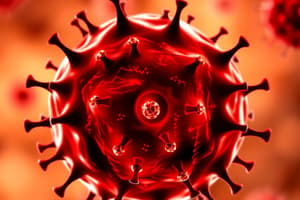Podcast
Questions and Answers
What type of immunity is present at birth and responds non-specifically to pathogens?
What type of immunity is present at birth and responds non-specifically to pathogens?
- Passive Immunity
- Innate Immunity (correct)
- Acquired Immunity
- Adaptive Immunity
Which process is NOT a stage of inflammation?
Which process is NOT a stage of inflammation?
- Increased vascular permeability
- Phagocytosis
- Wound contraction (correct)
- Vasodilation
Which factor is known to inhibit wound healing?
Which factor is known to inhibit wound healing?
- Proper nutrition
- Wound infection (correct)
- Healthy weight
- Increased oxygen supply
What characterizes primary intention wound healing?
What characterizes primary intention wound healing?
Which type of immunity involves B cells and T cells?
Which type of immunity involves B cells and T cells?
What is a typical sign of inflammation?
What is a typical sign of inflammation?
Which phase of wound healing occurs when healing takes place from the deeper layers up to the surface?
Which phase of wound healing occurs when healing takes place from the deeper layers up to the surface?
What is the initial antibody produced during the primary immune response?
What is the initial antibody produced during the primary immune response?
What is a bronchial response to an allergen during an inflammatory reaction primarily characterized by?
What is a bronchial response to an allergen during an inflammatory reaction primarily characterized by?
Which of the following describes a challenge in wound healing for older adults?
Which of the following describes a challenge in wound healing for older adults?
What is primarily produced in response to a secondary encounter with an antigen?
What is primarily produced in response to a secondary encounter with an antigen?
Which factor influencing infection refers to the ability of a pathogen to invade and multiply?
Which factor influencing infection refers to the ability of a pathogen to invade and multiply?
What type of hypersensitivity reaction is mediated by IgE?
What type of hypersensitivity reaction is mediated by IgE?
What is the result of HIV infection in terms of immune cells?
What is the result of HIV infection in terms of immune cells?
What characterizes chronic stress in relation to the immune system?
What characterizes chronic stress in relation to the immune system?
In which type of transplant rejection does the immune response occur immediately due to pre-existing antibodies?
In which type of transplant rejection does the immune response occur immediately due to pre-existing antibodies?
What autoimmune disease is identified by a butterfly-shaped rash?
What autoimmune disease is identified by a butterfly-shaped rash?
What is the main cause of transfusion reactions?
What is the main cause of transfusion reactions?
What type of immunity results from exposure to an antigen through infection or vaccination?
What type of immunity results from exposure to an antigen through infection or vaccination?
Which type of hypersensitivity is characterized by tissue-specific reactions, such as those seen in blood transfusion reactions?
Which type of hypersensitivity is characterized by tissue-specific reactions, such as those seen in blood transfusion reactions?
Flashcards
Innate Immunity
Innate Immunity
The body's first line of defense, present at birth, responds quickly and non-specifically to pathogens.
Acquired Immunity
Acquired Immunity
Develops after exposure to specific antigens, slower but highly specific, involving lymphocytes.
First Line of Defense
First Line of Defense
Physical, mechanical, and biochemical barriers like skin and mucous membranes.
Second Line of Defense
Second Line of Defense
Signup and view all the flashcards
Vasodilation
Vasodilation
Signup and view all the flashcards
Stages of Inflammation
Stages of Inflammation
Signup and view all the flashcards
Primary Intention Healing
Primary Intention Healing
Signup and view all the flashcards
Secondary Intention Healing
Secondary Intention Healing
Signup and view all the flashcards
Factors Inhibiting Wound Healing
Factors Inhibiting Wound Healing
Signup and view all the flashcards
Adaptive Immunity Primary Response
Adaptive Immunity Primary Response
Signup and view all the flashcards
Adaptive Immunity Secondary Response
Adaptive Immunity Secondary Response
Signup and view all the flashcards
Communicability
Communicability
Signup and view all the flashcards
Virulence
Virulence
Signup and view all the flashcards
Active Immunity
Active Immunity
Signup and view all the flashcards
HIV Infection
HIV Infection
Signup and view all the flashcards
Type I Hypersensitivity
Type I Hypersensitivity
Signup and view all the flashcards
Autoimmunity
Autoimmunity
Signup and view all the flashcards
Transfusion Reactions
Transfusion Reactions
Signup and view all the flashcards
Transplant Rejection
Transplant Rejection
Signup and view all the flashcards
Study Notes
Innate vs. Acquired Immunity
- Innate Immunity: The body's first line of defense, present at birth, responds quickly and non-specifically to pathogens. Includes physical barriers like skin and mucous membranes, and immune cells like phagocytes.
- Acquired (Adaptive) Immunity: Develops after exposure to specific antigens, slower but highly specific. Involves lymphocytes (B and T cells), has memory and provides long-term protection.
Lines of Defense
- First Line: Physical, mechanical, and biochemical barriers like skin and mucous membranes.
- Second Line: Inflammation - a rapid response to injury or infection involving immune cells like neutrophils and macrophages.
- Third Line: Adaptive immunity involving lymphocytes (B and T cells) and the production of antibodies.
Inflammation Process
- Stages:
- Vasodilation: Increased blood flow to the area.
- Increased vascular permeability: Fluid and immune cells leak from blood vessels into the tissues.
- White blood cell migration: Phagocytes engulf and destroy pathogens.
- Signs: Redness, heat, swelling, pain, and loss of function.
Wound Healing
- Primary Intention: Minimal tissue loss, wound edges are approximated, heals quickly with minimal scarring.
- Secondary Intention: More extensive tissue loss, heals from the bottom up with more tissue replacement and a higher chance of scarring.
Factors Inhibiting Wound Healing
- Ischemia (lack of oxygen)
- Excessive bleeding
- Obesity
- Diabetes
- Wound infection
- Tobacco use
- Age
Pediatric and Geriatric Considerations in Wound Healing
- Pediatric: Newborns rely on maternal antibodies for immunity and have underdeveloped immune responses.
- Geriatric: Older adults may have impaired healing due to chronic illnesses, reduced immune function, and medications.
Adaptive Immunity
- Primary Response: Initial exposure to an antigen, takes about 7-14 days to produce antibodies (IgM first, then IgG).
- Secondary Response: Memory cells quickly recognize the antigen, producing a faster and stronger response (predominantly IgG).
Factors Influencing Infection
- Communicability: Ability to spread from one individual to another.
- Infectivity: Ability to invade and multiply in a host.
- Virulence: Severity of the disease caused by the pathogen.
- Pathogenicity: Ability of an organism to cause disease.
Active Immunity
- Results from exposure to an antigen (through infection or vaccination) leading to the production of specific antibodies.
HIV/AIDS
- HIV: Infects and destroys CD4+ T-helper cells, impairing both humoral and cell-mediated immune responses.
- AIDS: The progression of HIV, marked by a severe decline in immune function, leaving the body vulnerable to opportunistic infections.
Hypersensitivity
- Type I: IgE-mediated, common in allergies.
- Type II: Tissue-specific reactions, e.g., blood transfusion reactions
- Type III: Immune complex-mediated, as in lupus.
- Type IV: Cell-mediated, like poison ivy reactions.
Autoimmunity
- The immune system mistakenly attacks the body’s own tissues, as seen in diseases like lupus.
Lupus
- A chronic autoimmune disease characterized by a variety of symptoms, including the signature butterfly rash, joint pain, and systemic inflammation.
Transfusion Reactions
- Occur when there is an immune response to transfused blood due to mismatched blood types (e.g., ABO or Rh incompatibilities). Symptoms may include fever, chills, shortness of breath, and low blood pressure.
Transplant Rejection
- The immune system attacks the transplanted organ:
- Hyperacute rejection: Immediate reaction due to pre-existing antibodies.
- Acute rejection: Occurs within weeks to months of transplantation.
- Chronic rejection: Develops over months or years, leading to gradual organ damage.
Stress and the Body's Response
- The HPA axis is activated during stress, leading to the release of cortisol, which elevates blood glucose and suppresses the immune response.
- Chronic stress is linked to several health issues, including cardiovascular diseases and immune suppression.
Immunity and Stress
- Stress can lower immune function by reducing T-cell cytotoxicity and B-cell responses, increasing susceptibility to infections and diseases.
Studying That Suits You
Use AI to generate personalized quizzes and flashcards to suit your learning preferences.




